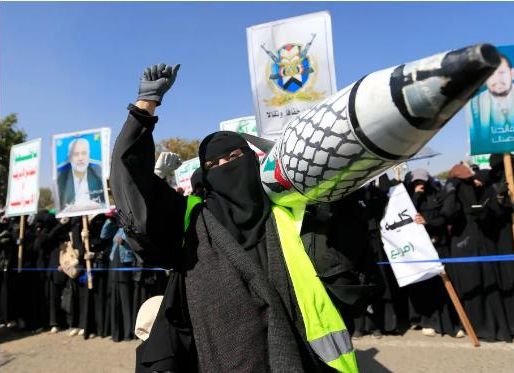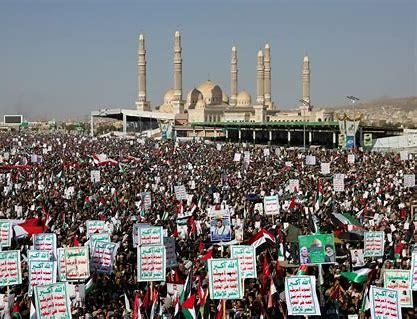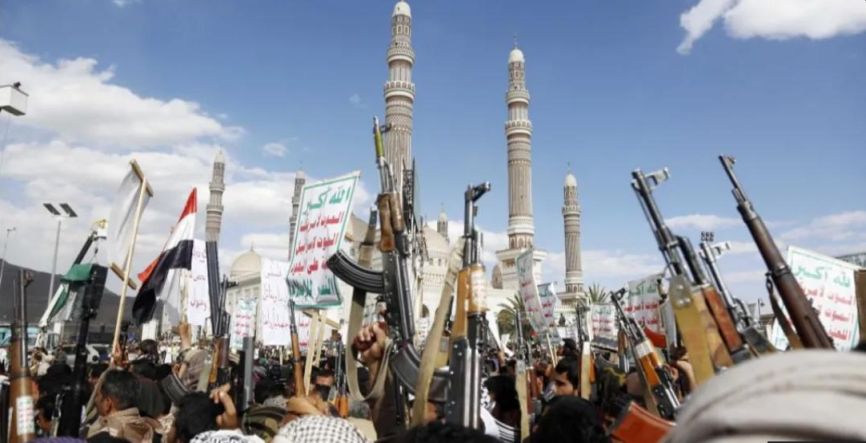By Eric Vandenbroeck and co-workers
Yemen's rebel Houthi
group has said it has fired a missile at Israel, which was
intercepted. The air strikes on Thursday reportedly targeted six homes
east of Khan Younis, a spokesman for the Hamas-run civil defence
agency said, and also injured dozens of people.
"A missile
launched from Yemen was intercepted by the IAF prior to crossing into Israeli
territory. Sirens were sounded in accordance with protocol," the Israeli
military said in a statement, referring to its air force.
While the fighting
power and military arsenal of other Iran-backed proxies in the so-called axis
of resistance, Hamas and Hezbollah, have been eroded significantly since the
attack on Israel on Oct. 7, 2023, the Houthi
movement has survived relatively unscathed. Since the cease-fire and
hostage deal was announced between Israel and Hamas in January, the Houthis
have been on standby as the de facto enforcers of the agreement, retaining the
leverage to resume violence at a time of their choosing. On March 11, the
Houthis announced that the group would resume its attacks in the Red
Sea as a response to Israel blocking humanitarian aid entering Gaza. This
balance of asymmetrical power is what the United States seems to be targeting
in a series of intense airstrikes that could extend into the coming weeks.
The shift in U.S.
policy under the Trump administration, from targeted strikes to a broader, more
aggressive campaign, marks a significant escalation. This change reflects a
hardening stance against the Houthis, moving beyond containment to active
disruption of their capabilities. The decision to target political leadership
alongside military assets suggests a desire to dismantle the Houthis’
organizational structure, not just degrade the immediate military threat they
pose.
What Can U.S. Strikes Accomplish?
In early March, the
U.S. State Department re-designated the Houthis as a foreign
terrorist organization, imposing sanctions on key financial operatives,
including Mohammed Abdulsalam the Houthi spokesperson and chief
negotiator. Abdulsalam, who controls an oil conglomerate and once
monopolized oil imports into northern Yemen according to our Yemen-based
sources, had been engaged in a period of sustained talks that began at the end
of April 2022 with the Saudis inside Oman. Open-source
reporting acknowledges
that talks began in October.
By conducting the
strikes, the United States is supporting the interests of regional allies that
are in trouble stemming from persistent Houthi armed politics and warmongering
in Yemen and across its borders. Where the Houthi disruption in the Red Sea has
hit the hardest is Egypt, which has lost up to $7 billion in
revenues through the
Suez Canal as vessels avoided Houthi attacks in 2024. The United Arab Emirates
has military, commercial, and economic interests in the Red Sea region. Saudi
Arabia has been stuck in a yearslong, stalling diplomatic process with no end
in sight.
During the course of
the first phase of the cease-fire in Gaza, the Houthis stuck to their word not
to attack Israeli-flagged or other commercial vessels in the Red Sea. But the
collapsing cease-fire deal is remobilizing the Houthis to target Israel directly,
which they have done in the past through drones and ballistic missiles,
although almost all have been intercepted. U.S. strikes aiming to incapacitate
the group’s senior leaders and erode its military infrastructure will attempt
to prevent the Houthis from taking retaliatory action.
Second, diverting
their attention away from kinetic activity in the coastal waters freed up the
Houthis to threaten their
political opponents in
Yemen’s Presidential Leadership Council. The prospect of a Houthi-controlled
Yemen is a risk to U.S. and allied interests in the Middle East as it would
gift Iran access to the country’s coveted coastal region, the strategic Hodeidah seaport, and its border with Saudi Arabia,
potentially using Yemen as a launching pad for regional instability.
Are the Houthis the Next Hezbollah?
The complicating
factor is that the Houthis are far more than a group of thugs or ragtag army of
bandits. Instead, acting as a rebel governance movement, the Houthis command a
war economy that allows them to profit from illegal smuggling of commodities that
range from fuel to cigarettes, while extracting tax revenues and stamp duties
as a de facto state-like entity in Sanaa and northern Yemen, where it claims
political authority. A sustained U.S. military campaign may degrade the grip
that the Houthis hold over Yemen’s seaports and smuggling networks that
allow them to trade in illegal goods, procure dual-use components, and
secure their resilience.
In recent years,
high-level Hezbollah and Iranian Islamic Revolutionary Guard Corps (IRGC)
officials have been known to
support the Houthis
with technical training and intelligence-sharing. Following the overthrow of
the regime of Bashar al-Assad in Syria in December, our research has tracked an
upward trend in the movement of former Lebanon- and Syria-based Hezbollah commanders
and fighters, as well as Shiite militia from Iraq, to Houthi-controlled areas
in Yemen.
In our assessment,
cross-border activity across the Lebanon-Syria-Iraq axis toward Yemen is part
of a trend of remobilization and realignment as Hezbollah and Hamas are
strategically downgraded. The Houthis have a
presence in Iraq, with a
bureau in Baghdad and smaller offices in Kirkuk and southern Iraq. While
difficult to confirm, some confidential sources inside Iraq have told us that
Houthi fighters use a training camp in the town of Khalis, Diyala in an area
controlled by Kata’ib Hezbollah. Our interviews
suggest that some military personnel within the Hashd al-Shaabi, or Popular
Mobilization Forces (the Iran-backed Shiite paramilitary structure), have been
deployed over the past three to four months to Yemen to train local fighters in
emerging combat technologies, armed drone deployment, and improvised explosive
device attacks. The cross-pollination of axis groups improves the Houthis’
military capabilities and operational tactics and has empowered them to
continue to leverage a credible threat against maritime shipping lanes.
The balance of power
along the Iranian axis has been shifting to the Houthis in Yemen, which have
emerged as the most well-equipped and financed non-state armed group aligned
with Iran in the new security landscape following the decline of Hezbollah’s defensive
and offensive capabilities. Outside of direct Iranian influence, the Houthis
have also been opportunistically engaging with
al-Shabaab, the
Somali affiliate of al Qaeda, and al Qaeda in the Arabian Peninsula. That the
U.S. strikes come now, and with such intensity, is a testament to this
coalescing of armed actors across the region.

Retreat, Recover, or Resolve?
While Hezbollah has
retreated to rebuild its military capabilities, the Houthis have shown resolve
to step up, issuing ultimatums to Israel and acting brazenly to consolidate
their domestic grip on power. The Houthis see themselves as playing the role that
Hezbollah once played. At the same time, the Houthis have increased
their footprint in Iraq,
with their members being embedded with Shiite Iraqi militias. The Houthis have
also moved some of their operations from Yemen to Iraq and have created, as
well as plugged into existing, shell companies to benefit from the Iraqi
financial system that operates at the behest of Iranian interests.
Iran has helped the Houthis in proliferating drones and ballistic missiles.
Tehran views the group as a valuable ally and will not shy from directing the
IRGC’s efforts to bolster the Houthis’ capabilities even as Iran is under
pressure domestically after expenditures in the billions of dollars to prop up
Hezbollah, Hamas, and the Assad regime. In the short term, the Houthis are
gaining some recognition and can sustain if they are not facing strong military
pressure—something that can change under the Trump administration.
It is unclear how far
the Trump administration is willing to go in its current military campaign.
While the Houthi attacks are focused on the maritime routes, the problem is
essentially a land problem. The Houthi control along the west coast of Yemen is
what makes the attacks more decisive and highly disruptive. Most observers
agree that a ground operation by U.S. forces is very unlikely, which means
there is a clear limitation to how much the U.S. can achieve through military
means alone. The Houthis’ control of a large part of Yemen and the mountainous
landscape makes them able to absorb an aerial campaign.

However, if these
attacks continue with the same pace for a sustained period, this will motivate
the Houthi opponents to start capitalizing on the Houthis’ losses and their
inability to move forces freely between the different front lines. The conflict
in Yemen is at a stalemate, but the Houthis haven’t signed any agreement with
their local rivals. Also, local grievances in the last two years have surfaced,
which the Houthis have managed to suppress with extreme force. The economic
pressure the Houthis are facing will also make it hard to mobilize fighters and
finance a new round of conflict. The Houthis realize they are currently at a
disadvantage but are counting on the United States losing interest throughout a
protracted military campaign. In other words, America’s limitation is what the
Houthis will count on to avoid a collapse similar to the Assad regime and
Hezbollah.

For updates click hompage here